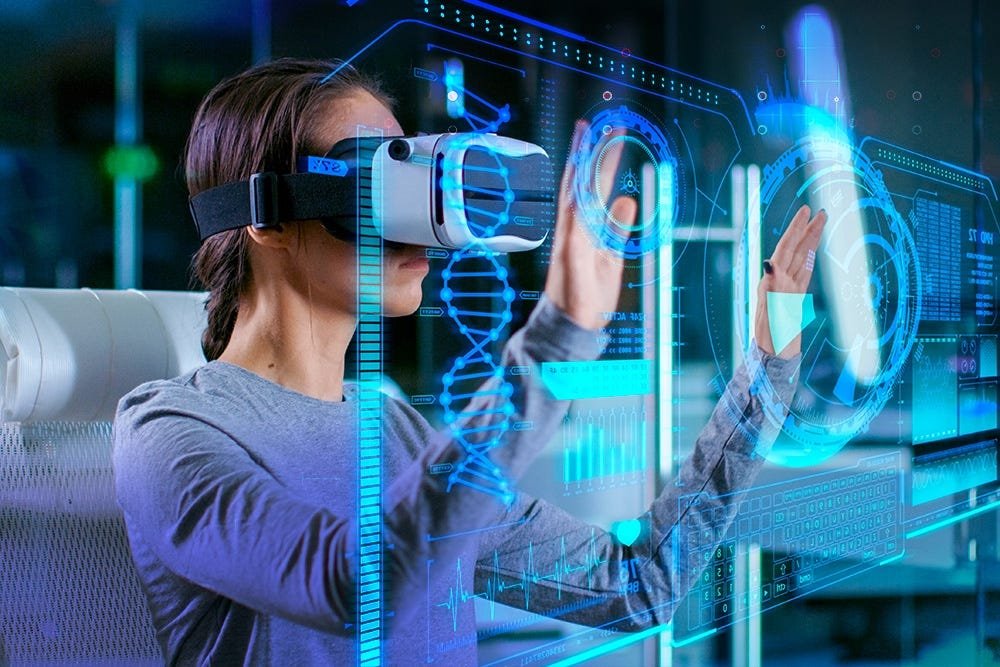Virtual Reality (VR) technology has come a long way in recent years, transforming the way we experience digital content and opening up a world of possibilities. From gaming and entertainment to education and training, VR offers immersive experiences that transport users to virtual realms. In this article, we will explore the concept of virtual reality, its current applications, and the potential it holds for the future of immersive experiences.
Table of Contents
What is Virtual Reality?
Virtual Reality refers to a computer-generated simulation that replicates an environment, real or imagined and allows users to interact with it through sensory experiences. By wearing a VR headset, users are visually and audibly immersed in a 3D virtual environment that gives them a sense of presence and the feeling of being “inside” the virtual world.
Current Applications of Virtual Reality- Gaming and Entertainment
Gaming is one of the most popular applications of VR. Virtual reality gaming provides an unprecedented level of immersion, allowing players to feel like they are part of the game world. From action-packed adventures to realistic simulations, VR gaming delivers a heightened sense of excitement and engagement.
Training and Simulation
Virtual Reality is increasingly being used for training purposes in various industries. For example, pilots can practice flight simulations, medical professionals can perform virtual surgeries, and military personnel can undergo combat training in a safe and controlled environment. VR simulations offer a cost-effective and risk-free way to train individuals in complex and high-stakes scenarios.
Education and Learning
Virtual Reality has the potential to revolutionize education by creating interactive and immersive learning experiences. Students can explore historical sites, dive into the depths of the ocean, or travel to distant planets, all from the classroom. VR enables a more engaging and impactful learning environment, enhancing students’ understanding and retention of information.
Architecture and Design
Architects and designers can use VR to create virtual walkthroughs of buildings and spaces before they are constructed. This allows clients and stakeholders to visualize and provide feedback on designs, making the design process more efficient and collaborative.
Healthcare and Therapy
Virtual Reality has shown promise in various healthcare applications. It can be used for pain management, phobia treatment, physical rehabilitation, and mental health therapy.
VR environments provide a controlled and immersive setting for patients to confront and overcome their fears or engage in therapeutic activities.
The Future of Immersive Experiences
As technology continues to advance, the future of virtual reality holds immense potential for even more immersive experiences. Here are some areas where VR is expected to make significant advancements.
Social Interaction
Virtual Reality has the potential to revolutionize social experiences. With advancements in VR technology, users will be able to interact with others in shared virtual spaces, attend virtual events, collaborate on projects, or simply socialize with friends and family across the globe. VR has the power to bridge geographical distances and create meaningful connections.
Healthcare and Telemedicine
Virtual Reality can transport individuals to different parts of the world, allowing them to explore exotic locations and cultural landmarks without leaving their homes. Virtual travel experiences can offer a glimpse into destinations, fostering a sense of wanderlust and promoting cultural understanding.
Collaboration and Remote Work
VR can revolutionize the way teams collaborate and work remotely. By creating virtual meeting spaces and immersive work environments, VR can enhance productivity and teamwork, even when team members are physically apart. Remote workers can have a sense of presence and engage in virtual interactions that mimic face-to-face communication.
Art and Creativity
Virtual Reality opens up new possibilities for artistic expression and creativity. Artists can create immersive VR experiences, interactive installations, and three-dimensional artworks. VR can also revolutionize the way audiences experience and engage with art, providing a more immersive and interactive platform for artistic exploration.
Establish social boundaries
Consider making guidelines about keeping your devices away from real face-to-face interactions and other social situations. It’s crucial to set aside an hour or two to reconnect with the essential
people in your life. When you look around a cafe, you will frequently notice that everyone is still engrossed in their phones and entirely disengaged from the individual they are seated across from. Consider making it a rule that you must put away your phone during meetings, dates, and get-togethers with pals. According to studies, the sheer presence of a cell phone is enough to cause a distraction for everyone in the room. Put your phone in your handbag to avoid temptation and enjoy face-to-face interaction.
Conclusion
Virtual Reality has evolved from a sci-fi concept to a tangible technology that is transforming various industries. With its ability to provide immersive and interactive experiences, VR has the potential to revolutionize gaming, education, training, healthcare, and more. As technology continues to advance, we can expect even more exciting developments in the field of virtual Reality, creating a future where immersive experiences become an integral part of our daily lives.



